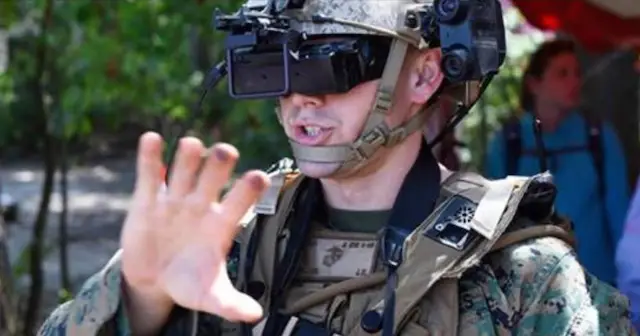Breaking news
ONR’s augmented reality system tested during a live-fire exercise 40809152.
|
|
|||
|
Defence & Security News - (USA)
|
|||
|
|
|||
| ONR’s augmented reality system tested during a live-fire exercise | |||
|
The ONR-developed augmented reality technology system was put for the first time in testing during a live-fire exercise of the USMC, at the end of August, according to a statement by the Office of Naval Research. |
|||
|
|
|||
 Augmented Immersive Team Trainer helmet-mounted display (Source: ONR) |
|||
|
|
|||
|
The AITT (Augmented Immersive Team Trainer) was developed by the ONR. As its name signifies, the system uses augmented reality by superimposing virtual objects over the real environment picture. It is comprised of a helmet-mounted display, a laptop computer, its software and a battery pack. “The AITT system is like the Marine Corps itself: lean, agile and adaptable,” said Brig. Gen. Julian Alford, vice chief of naval research and commanding general of the Marine Corps Warfighting Laboratory. “This affordable lightweight system can be taken anywhere—turning any environment into a training ground—and could be used to prepare Marines for real-world situations and environments they will face.” The field portion of the “call-for-fire” training included aircraft and munitions, which are costly and time-consuming to set up, staff and equip, but an important part of the training experience for the student officers. The wait time for a test range can be six to 12 months, rain can cancel the testing and it can be difficult to get assets in place, since equipment can break down. The AITT completely bypasses these challenges by using virtual ground vehicles, aircraft and munitions. “The system makes the training easier and eliminates the maintenance issues or weather-related restrictions that can pare down or cancel training,” said Maj. George Flynn, director of the Infantry Officer Course. “For instance, this system can use virtual air support, so even if it’s raining, the students can still be training, getting confidence and learning the points of employing aviation assets.” The system will enable the student officers to use virtual assets to complement live training or to get additional practice repetitions without having to use live assets, said Dr. Peter Squire, a program officer with ONR’s Expeditionary Maneuver Warfare and Combating Terrorism Department who’s leading the AITT effort. “And instead of using your imagination, now you can see virtual effects from the blasts, like smoke.” Flynn emphasized that seeing virtual effects makes it much easier for the student to picture the situation. “Rather than having the instructor paint a picture to the student without anything happening, now the student can get a visual of the aircraft they’ve been controlling in support of a maneuver on the deck,” he said. Flynn envisioned more potential uses for AITT in the future: “For example, as part of a company training event, a rifle platoon could be conducting a live-fire attack on a range at the Marine Corps Air Ground Combat Center, while the Fire Support Team could be on the hill practicing employing fires in support of maneuver, using virtual effects.” The AITT program—part of the ONR Capable Manpower Future Naval Capability—will wrap up its fifth and final year with a large-scale demonstration at Quantico, scheduled for October. Pending the results of a Marine Corps assessment in October, the program will transition to the Marine Corps Program Manager for Training Systems for further testing and development. |
|||



















